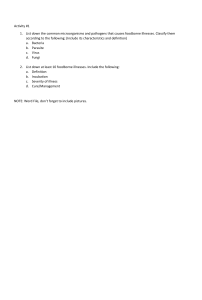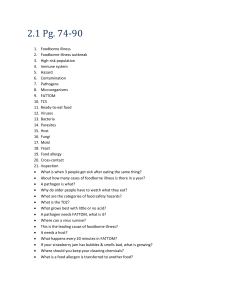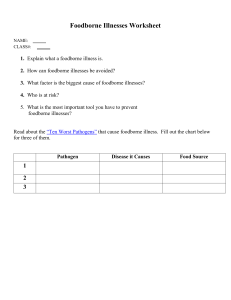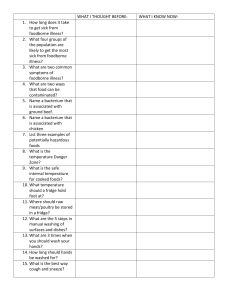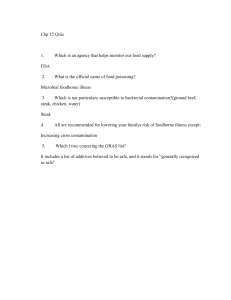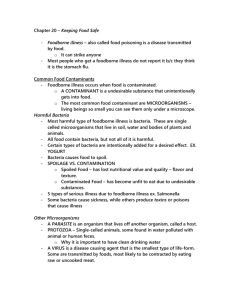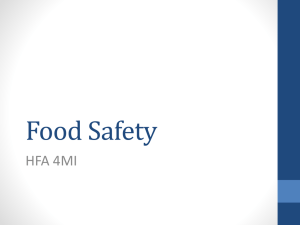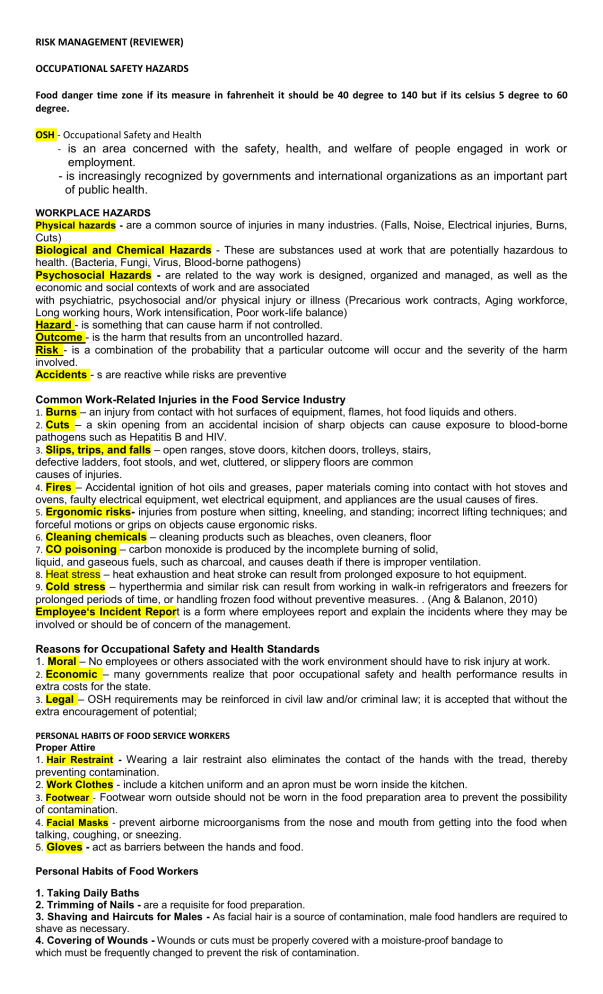
RISK MANAGEMENT (REVIEWER) OCCUPATIONAL SAFETY HAZARDS Food danger time zone if its measure in fahrenheit it should be 40 degree to 140 but if its celsius 5 degree to 60 degree. OSH - Occupational Safety and Health - is an area concerned with the safety, health, and welfare of people engaged in work or employment. - is increasingly recognized by governments and international organizations as an important part of public health. WORKPLACE HAZARDS Physical hazards - are a common source of injuries in many industries. (Falls, Noise, Electrical injuries, Burns, Cuts) Biological and Chemical Hazards - These are substances used at work that are potentially hazardous to health. (Bacteria, Fungi, Virus, Blood-borne pathogens) Psychosocial Hazards - are related to the way work is designed, organized and managed, as well as the economic and social contexts of work and are associated with psychiatric, psychosocial and/or physical injury or illness (Precarious work contracts, Aging workforce, Long working hours, Work intensification, Poor work-life balance) Hazard - is something that can cause harm if not controlled. Outcome - is the harm that results from an uncontrolled hazard. Risk - is a combination of the probability that a particular outcome will occur and the severity of the harm involved. Accidents - s are reactive while risks are preventive Common Work-Related Injuries in the Food Service Industry 1. Burns – an injury from contact with hot surfaces of equipment, flames, hot food liquids and others. 2. Cuts – a skin opening from an accidental incision of sharp objects can cause exposure to blood-borne pathogens such as Hepatitis B and HIV. 3. Slips, trips, and falls – open ranges, stove doors, kitchen doors, trolleys, stairs, defective ladders, foot stools, and wet, cluttered, or slippery floors are common causes of injuries. 4. Fires – Accidental ignition of hot oils and greases, paper materials coming into contact with hot stoves and ovens, faulty electrical equipment, wet electrical equipment, and appliances are the usual causes of fires. 5. Ergonomic risks- injuries from posture when sitting, kneeling, and standing; incorrect lifting techniques; and forceful motions or grips on objects cause ergonomic risks. 6. Cleaning chemicals – cleaning products such as bleaches, oven cleaners, floor 7. CO poisoning – carbon monoxide is produced by the incomplete burning of solid, liquid, and gaseous fuels, such as charcoal, and causes death if there is improper ventilation. 8. Heat stress – heat exhaustion and heat stroke can result from prolonged exposure to hot equipment. 9. Cold stress – hyperthermia and similar risk can result from working in walk-in refrigerators and freezers for prolonged periods of time, or handling frozen food without preventive measures. . (Ang & Balanon, 2010) Employee‘s Incident Report is a form where employees report and explain the incidents where they may be involved or should be of concern of the management. Reasons for Occupational Safety and Health Standards 1. Moral – No employees or others associated with the work environment should have to risk injury at work. 2. Economic – many governments realize that poor occupational safety and health performance results in extra costs for the state. 3. Legal – OSH requirements may be reinforced in civil law and/or criminal law; it is accepted that without the extra encouragement of potential; PERSONAL HABITS OF FOOD SERVICE WORKERS Proper Attire 1. Hair Restraint - Wearing a lair restraint also eliminates the contact of the hands with the tread, thereby preventing contamination. 2. Work Clothes - include a kitchen uniform and an apron must be worn inside the kitchen. 3. Footwear - Footwear worn outside should not be worn in the food preparation area to prevent the possibility of contamination. 4. Facial Masks - prevent airborne microorganisms from the nose and mouth from getting into the food when talking, coughing, or sneezing. 5. Gloves - act as barriers between the hands and food. Personal Habits of Food Workers 1. Taking Daily Baths 2. Trimming of Nails - are a requisite for food preparation. 3. Shaving and Haircuts for Males - As facial hair is a source of contamination, male food handlers are required to shave as necessary. 4. Covering of Wounds - Wounds or cuts must be properly covered with a moisture-proof bandage to which must be frequently changed to prevent the risk of contamination. 5. Wearing of Jewelry - Aside from being a physical hazard, Jewelry may also become biological hazards as they have crevices that can harbor microbial growth. 6. Wearing of Nail Polish or False/Artifificial Fingernails 7. Smoking and Eating 8. Proper Hand Washing 9. Tasting of Food - A small amount of the food to be sampled must be transferred into a separate bowl. 10 Storing Personal Belongings 10. Other Personal Habits Cuts and Abrasions- such as burns and boils, should be covered with waterproof bandages or dressings. Employee Illnesses Education and Training Human skill is the ability to work harmoniously with others in the group so as to accomplish work efficiently. Technical skills refer to the knowledge of the methods, procedures and techniques needed in the performance of a particular activity. Conceptual skill means having an overall understanding of the foodservice operation. (Perdigon, 2009) Chapter 3: An Overview of Potential Hazards in Food Service Operations The Food Industry The food system is a complex, concentrated, and dynamic chain of activities that begins with the production of raw agricultural commodities on farms, orchards, and ranches and moves to valueadded processed and manufactured products and then to retail food stores and foodservice establishments (restaurants and institutions) where they are merchandised, prepared, and sold to consumers. FOOD SAFETY HAZARD - is a biological, chemical, or physical agent or condition in food that could potentially cause. an adverse human health effect. - it is anything in food that can cause harm to the consumer in the form of foodborne illnesses. FOODBORNE ILLNESS - are defined as diseases, either infectious or toxic in nature, caused by agents that enter the body- through the ingestion of food. BIOLOGICAL ● Bacteria ● Parasites and helminths ● Virus ● Fungi ● Prion CHEMICAL ●Agricultural chemicals(pesticides) ●Natural plant toxins ●Animal toxins ●Food additives ●Medications ●Radioactive substances ●Alcohol PHYSICAL ●Foreign objects in food such as: -Hair -Pebbles -Glass shards -Toothpick -Plastic -Metal fragments -Fabrics SOURCES OF FOOD SAFETY HAZARDS Hazards can contaminate food through the following factors: material, men, method, machine, money, and environment. CONTAMINATION - is the unintended presence of a harmful substance in food while cross-contamination is the transfer of such harmful substances from one food to another through a non-food surface, such as cooking wares, equipment, and food workers. (Ang & Balanon, 2010) General Categories of Contamination 1. Inherent in Raw Material Raw food materials may appear clean, but microorganisms, chemicals, even foreign objects, may be found in the raw food as it is grown, harvested, caught or slaughtered. 2. Contamination through Time Temperature Abuse A food is said to have been time temperature abused if it has been allowed to stay too long at temperatures favorable to the growth of microorganisms. This temperature referred to as the Temperature Danger Zone. 3. Cross-contamination - occurs when microorganisms are transferred from a contaminated food contact surface or food to a non-contaminated food contact surface or food. 4. Poor Person at Hygiene The most common source of foodborne illness can be traced to food handlers. POTENTIALLY HAZARDOUS FOOD (PHF) POTENTIALLY HAZARDOUS - Some types of food have the ability to support the rapid, progressive growth of infections and toxin producing microorganisms. CHARACTERISTICS: A history of being involved in foodborne illness outbreaks Salmonellosis in peanut butter A natural potential for contamination. Contamination occurs due to the methods used to produce and process food High protein and carbohydrate. Not acidic enough to inhibit the growth of microorganisms. FOODBORNE ILLNESSES FOOD POISONING - is considered to be an illness caused by the consumption of food containing microbial toxins or chemical poisons. FOOD INTOXICATION - food poisoning caused by bacterial toxins FOOD TOXICOINFECTIONS - foodborne illnesses caused from a combination of food intoxication and food infection PSYCHOSOMATIC FOOD ILLNESS - Illness caused by the mind, due to one witnessing another human sick or to the sight of a foreign object, such as an insect or rodent, in a food product, SYMPTOMS OF FOODBORNE ILLNESSES ● abdominal cramps, ● nausea, ● vomiting, ● diarrhea. which is sometimes bloody, ● fever ● dehydration, and ● headache. RISK FACTORS OF FOODBORNE ILLNESSES Some people are at a greater risk for bacterial infections because of their age or unhealthy immune system. SOCIO- ECONOMIC EFFECTS OF FOODBORNE ILLNESSES 1. Costs that may be incurred by the sick individual or caregiver/family 2. Business and industry Costs 3. Costs to the nation and government POINTS TO REMENIBER REGARDING POTENTIAL HAZARDS IN FOOD SERVICE OPERATIONS Foodborne illnesses are acquired from eating food or drinking beverages contaminated with bacteria, viruses, or parasites. People at greater risk for foodborne illnesses include young children, pregnant women and their unborn child, elderly, and people with lowered immunity. Symptoms usually resemble intestinal flu Treatment may range from the replacement of lost flfluids and electrolytes for mild cases of foodborne illnesses to hospitalization for severe conditions such as Hemolytic-uremic syndrome. Foodborne hazards can be classified as biological, chemical, or physical. Biological hazards can be caused by parasites, viruses, or bacteria. Chemical contaminants in foods can come from industrial and agricultural sources, food processing, or the food itself. Toxic chemicals also come from biological sources such as molds and algae. Foreign objects present in food could constitute a physical hazard to the consumer. BIOLOGICAL HAZARDS - are acquired from disease- causing microorganisms and the poisonous toxins they may produce - are by far the most dangerous foodborne hazard in the food service and food retail businesses. A foodborne illness is generally classified as a foodborne infection, intoxication, or toxin- mediated infection. CLASSIFICATION OF FOODBORNE ILLNESS ● Infection- ingestion of a harmful microorganism in food - occurs when a living microorganism is ingested as a part of food. ● Intoxication- ingestion of a harmful toxin produced in food - arises when a living microorganism that grows in food produces a toxin. - may also occur due to the consumption of a toxic chemical, such as a cleaning chemical. ● Toxin- Mediated Infection- ingestion of a harmful microorganism in food that produces a toxin in the human body - takes place when a living microorganism is consumed and the ingested microorganism produces a toxin in the body that leads to illness TYPES OF MICROORGANISMS 1. Beneficial Microorganisms- Beneficial microorganisms are found in food production. Examples of these microbes are those used in making bread, beer, yoghurt, and cheese. 2. Harmful Microorganisms- Harmful microorganisms spoil food and cause diseases. MICROBIAL FORMS BACTERIA - provide the most common threat to food safety - are single- celled organisms and can cause illnesses in two ways. 1. Pathogenic (infectious; disease- causing) bacteria multiply rapidly in favorable conditions provided by PHF 2. Toxigenic (poisonous) bacteria produce harmful toxins Bacteria are classified as either spoilage or pathogenic microorganisms. a. Spoilage bacteria break down foods making them look, taste, and smell bad. They reduce the quality of food to unacceptable levels b. Pathogenic bacteria are disease causing microorganisms that can make people ill if they or their toxins are consumed through food. BINARY FISSION - Bacteria reproduce when bacterial cell divides to form two new cells GENERATION TIME - or the time for cell numbers to double is typically 20-30 minutes but can also be quick as 15 minutes Phases of Bacterial Growth 1. Lag Phase. Growth is slow at first, while the microorganisms acclimate to the food and nutrients in their new habitat. 2. Log Phase. Once the metabolic machinery is running, microbes start multiplying exponentially, doubling in number every few minutes. 3. Stationary Phase. As more and more microbes are competing for dwindling food and nutrients, the booming growth stops and the number of bacteria stabilizes. 4. Death Phase. Toxic waste products build up, food is depleted and the microorganisms begin to die. FATTOM - FOOD, ACIDITY, TIME, TEMPERATURE, OXYGEN AND MOISTURE FOOD - Microorganisms like all living things, need food to grow ACIDITY - Disease- causing bacteria grow best at acidity levels equivalent to pH 4.6 to 7.5. TEMPERATURE - is probably the most important factor that affects the growth of bacteria in food. Classification of Microorganisms according to Temperature Requirements 1. Psychrophiles - These cold temperature loving microorganisms thrive in a temperature range of 0°C to 21°C. They are especially troublesome because they are capable of multiplying at both refrigerated and room temperatures. Most psychophysics bacteria are spoilage organisms, but 2. Mesophiles - Theses middle range bacteria grow at temperatures between 21°C and 43°C, with the most rapid growth at human body temperature. 3. Thermophiles - Heat- loving microorganisms, they grow best at temperatures above 43°C. all thermophilic bacteria are spoilage organisms. TIME -A rule of thumb in the food industry is that bacteria need about four hours, inclusive of the time food is between 5°C to 60°C, to grow to numbers high enough to cause illness. Temperature abuse is the term applied to food that have not been heated to or kept at the proper temperature. Time and temperature are the most critical factors affecting the growth of bacteria in foods. OXYGEN - Some require a lot of oxygen (aerobic), while others cannot tolerate oxygen (anaerobic) at all. MOISTURE- terial growth, which is why humans have been preserving food for thousands of years by drying them. Foodborne Illnesses Caused by Bacteria Spore-Forming Foodborne Bacteria - The following group of bacteria can produce a spore structure that allows a cell to withstand environmental stress, such as cooking, freezing, salting, drying, and picking. - generally found in ingredients grown near the soil like vegetables and spices. Important spore-forming pathogens in the food retail industry include: 1. Bacillus cereus - is a facultative anaerobic, spore-forming bacterium that has been associated with two very different types of illnesses. (Type of Illness: Bacterial intoxication or toxin-mediated infection) 2. Clostridium perfringens - is an anaerobic, spore-forming bacterium that is one of the most commonly reported causes of foodborne illnesses, especially for food that have been temperature abused. - causes illness due to a toxic-infection where the ingested cells produce a toxins in the human intestinal tract. (Type of Illness: Bacterial toxin-mediated infection) 3. Clostridium botulinum - is an anaerobic, spore-forming bacterium that causes foodborne intoxication due to improperly heat processed foods, especially home canning ones.(Type of Illness: Bacterial intoxication) Nonspore forming Foodborne Bacteria - The following groups of bacteria are not capable of producing a spore structure; they are always in the vegetative state. 1. Campylobacter jejuni - is considered by many food scientists as the number one agent that causes foodborne illnesses. (Type of Illness: Bacterial infection) 2. Escherichia coli - is a facultative anaerobic bacterium that can be found in the intestines of warm-blooded animals. (Type of Illness: Bacterial infection or toxinmediated infection ) 3. Listeria monocytogenes - is a facultative anaerobic bacterium that causes foodborne infection. It can survive under many conditions, even in high-salt food. (Type of Illness: Bacterial infection) 4. Salmonella spp - Salmonella is a facultative anaerobic bacterium that frequently causes a foodborne infection.( Type of Illness: Bacterial infection) 5. Shigella spp - It is frequently found in the intestines of humans and warm-blooded animals and can cause an infection or toxic-infection. A common illness caused by Shigella is bacillary dysentery.(Type of Illness: Bacterial infection) 6. Staphylococcus aureus - is a facultative anaerobic bacterium that produce a very heat-stable toxin as it grows on food, an example of an intoxication. This bacterium can grow on cooked foods that are recontaminated by food workers through mishandling them. (Type of Illness: Bacterial intoxication) - bacterium does not compete well when other types of microorganisms are present. 7. Vibrio spp - There are three species within the Vibrio group of bacteria that have been implicated in foodborne infections. (Vibrio cholera, vibrio, parahaemolyticus, and Vibrio vulnificus, all of which are resistant to salt and are common in seafood. Foodborne Illnesses Caused by Viruses 1. Hepatitis A - is a foodborne virus associated with many foodborne infections. It causes the liver disease infectious hepatitis - is very resilient and can live for several hours in a suitable environment 2. Norwalk virus group - is a common foodborne virus associated with many foodborne infections - the virus can be ingested through raw seafood, and raw fruits and vegetables washed with a contaminated water supply. 3. Rotavirus - These viruses are the leading causes of severe diarrhea among infants and children. Foodborne Illnesses Caused by Parasites Parasites - are microscopic creatures that need to live on or inside a host to survive. - can be found in irrigation water, animal feces, muscle tissues of improperly fed cattle and swine, and fish muscles. 1. Anisakis spp - are nematodes (roundworms) that have been associated with foodborne infection from fish. 2. Cryptosporidium parvum - is a single-celled microorganism called protozoa. They can cause foodborne infections and can be found in water that has been contaminated with cow feces. 3. Giardia lamblia - is found in the feces of wild animals, domestic pets, and infected persons. 4. Trichinella spiralis - is a foodborne roundworm that can cause parasitic infection. It can be found in an infected fleshy muscle and is eaten by certain meat-eating animals; these animals then transmit it to a new host. 5. Toxoplasmosis - this parasite is common in warm-blooded animals including cats, rats, pigs, cows, sheep, chicken, and birds. 6. Entamoeba histolytica - a single-celled parasitic animal that predominantly infects humans and other primates. 7. Ascaris lumbricoides - infections in humans occur when an ingested infective egg releases a larval worm that penetrates the wall of the duodenum and enters the bloodstream. 8. Taenia saginata (BEEF TAPEWORM) and Taenia solium (PORK TAPEWROM)- Taeniasis is the intestinal infection caused by adult-stage tapeworms. Cysticercosis, on the other hand, is the tissue infection caused by the larval-stage of the pork tapeworm. 9. Diphyllobothrium latum - and other members of the genus are broad fish tapeworms Foodborne Illnesses Caused by Fungi Fungus - is a eukaryotic organism that is a member of the kingdom Fungi. Fungi are heterotrophic organisms that possess a chitinous cell wall. (Yeasts, molds, and mushrooms) Types of Fungi Hazardous for Consumption 1. Molds - are microscopic fungi that live on plant or animal matter. Aflatoxin is a cancer-causing poison produced by certain fungi in or on food and feeds, especially in field corn and peanuts. Common Foodborne Molds Molds most often found on meat and poultry are Alternaria, Aspergillus, Botrytis, Cladosporium, Fusarium, Geotrichum, Monilia, Manoscus, Mortierella, Mucor, Neurospora, Oidium, Oosproa, Penicillium, Rhizopus and Thamnidium. These molds can also be found on many other foods. 2. Yeast - are single-celled fungi, in contrast to molds which are multicellular. They differ from bacteria by their larger cell size and shape, which may be oval, elongated, elliptical, or spherical. - used as an ingredient in bread making and is responsible for alcoholic fermentation needed in alcoholic beverages. 3. Mushrooms - are actually the fruit fungus. A. EDIBLE MUSHROOMS - are used extensively in cooking in many cuisines, notably Chinese, European and Japanese. 1. PUFFBALLS - have been mistaken at a distance for everything, from golf balls to sheep. 2. SHAGGY MANE (Coprinus Comatus) - lawyer's wig is large and distinctive. 3. CORAL FUNGI (Clavariaceae) - appears as clumps of branching stems which point upward. They do look much like coral. 4. Morels - are easy to recognize and delicious to eat, making them the most popular wild mushroom in Missouri Three Common Species of Morels 1. Common Morel (Morchella esculenta) 2. Black morel or smoky Morel (Morchella elata): 3. Half-free morel (Morchella semilibera) 4. Bearded Tooth (Hericium erinaceus) - With its clump of hanging white fur, this tooth fungus looks like a polar bear's paw. 5. Mushroom (Pleurotus ostreatus) - This large white, tan or ivory colored mushroom is named so for its oyster shell-like shape. 6. Chanterelles (Cantharellaceae) - These mushrooms are funnel- or trumpet-shaped and have wavy cap edges. 7. Boletes (Boletaceae) - Similar to a hamburger bun on thick stalk, these sturdy, fleshy mushroom can be mistaken at first glance for gilled ones 8. Sulfur Shelf (Laetiporus sulphureus) - These mushrooms light up the forest with their brilliant orange-red caps and pale sulfur-yellow pore surfaces. 9. Hen-of-the-woods (Grifola frondosa) - This mushrooms look something like a large, ruffled chicken B. Poisonous Mushrooms - are hard to distinguish from edible ones. The toxins involve in mushroom poisoning are produce naturally by the toxic species of this fungus. Most of them cannot be made nontoxic even with cooking, canning, freezing, or any other means of processing. Mushroom poisoning, also known as mycetism, refers to the deleterious effects caused by the ingestion of toxic substances present in a mushroom. 3 CATEGORIES OF MUSHROOM POISONING 1. Protoplasmic - This results in the generalized destruction of cells followed by organ failure. 2. Neurologic - This causes hallucinations, depression, coma and convulsion. 3. Gastrointestinal - This includes spastic colon, rapid nausea and vomiting, abdominal cramps and diarrhea. Common Poisonous Mushrooms 1. Amanitas - are the reason why there are no old, bold mushroom hunters. 2. False morels (Helvella and Gyromitra spp.) - Illnesses caused by false morels are difficult to treat because they can fit both categories--edible and poisonous mushrooms. 3. Little Brown Mushrooms (LBMs) - Like the LGBs (little gray birds) of the bird watchers, this is a catch all category. 4. Jack O' Lantern (Omphalotus olearius) - This bright orange mushrooms is well named 5. Green-spored lepiota (chlorophyllum molybdytes) - These large, common mushrooms often appear in fairy rings on suburban lawns, and are frequently eaten by the lawn owners. They cause a violent gastrointestinal upsets. Foodborne Illnesses Caused by Prions Prions - refer to proteinaceous infectious particles (PIP). - Prion disease, also called transmissible spongiform encephalopathies Mad Cow Disease - is the best known bovine spongiform encephalopathy (BSE). An infected cow is observed to be disoriented, irritable and unable to stand or walk properly Creutzfeldt-Jacob Disease (CJD) - is a rare and fatal neurodegenerative disease in humans Methods on How to Control Microbial Growth 1. Application of Heat 2. Application of Low Temperatures 3. Controlling of pH Conditions 4. Reduction of Free Oxygen 5. Reduction of Available Water 6. Role of Other Chemicals 7. Safe and Sanitary Food Handling PREVENTION OF FOODBORNE ILLNESSES A. Food Preparation Stage Refrigerate food promptly Prevent cross- contamination. Handle food properly Wash utensils and surfaces before and after use with hot, soapy water B. Food Processing Stage (Cooking) C. Food Storage Stage
